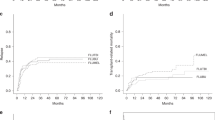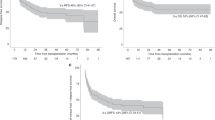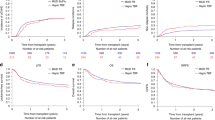Abstract
We retrospectively evaluated the outcome of reduced-intensity conditioning (RIC) followed by allogeneic hematopoietic stem cell transplantation (HCT) in 43 patients with myelodysplastic syndrome (MDS) or AML arising from MDS. All patients received fludarabine plus melphalan followed by an allogeneic HCT from an HLA-identical sibling (SIB: n=19) or unrelated donor (MUD: n=24). Median age was 58 years (range: 30–71). Diagnoses at transplantation were RA (n=8), RARS (n=1), RAEB (n=13), RAEB-T (n=6), or AML arising from MDS (n=15). Of 28 patients with MDS, two patients had low, 10 had intermediate-1, nine had intermediate-2 and seven had high-risk MDS by IPSS criteria. All patients initially engrafted with the median neutrophil recovery of 15 days (range: 9–27). The 2-year overall survival, disease-free survival, relapse and transplant-related mortality were 53.5% (CI 45.2–61.1), 51.2% (CI 43.3–58.5), 16.3% (CI 7.9–30.7) and 35.2% (26.4–45.7), respectively. Grade II–IV acute graft-versus-host disease occurred in 27 (63%) patients. There was no significant survival difference between SIB and MUD-HCT, but the relapse rate was higher among SIB donor recipients when compared to MUD (38.5 versus 7%, P=0.02). RIC with fludarabine plus melphalan was associated with durable disease control and acceptable toxicity in this high-risk cohort.
This is a preview of subscription content, access via your institution
Access options
Subscribe to this journal
Receive 12 print issues and online access
$259.00 per year
only $21.58 per issue
Buy this article
- Purchase on Springer Link
- Instant access to full article PDF
Prices may be subject to local taxes which are calculated during checkout



Similar content being viewed by others
References
Heaney ML, Golde DW . Myelodysplasia. N Engl J Med 1999; 340: 1649–1660.
Anderson JE, Appelbaum FR, Fisher LD, Schoch G, Shulman H, Anasetti C et al. Allogeneic bone marrow transplantation for 93 patients with myelodysplastic syndrome. Blood 1993; 82: 677–681.
Sutton L, Leblond V, Le Maignan C, Jouet JP, Kuentz M, Gluckman E et al. Bone marrow transplantation for myelodysplastic syndrome and secondary leukemia: outcome of 86 patients. Bone Marrow Transplant 1991; 7 (suppl. 2): 39.
Zikos P, Van Lint MT, Frassoni F, Lamparelli T, Gualandi F, Occhini D et al. Low transplant mortality in allogeneic bone marrow transplantation for acute myeloid leukemia: a randomized study of low-dose cyclosporin versus low-dose cyclosporin and low-dose methotrexate. Blood 1998; 91: 3503–3508.
Castro-Malaspina H, Harris RE, Gajewski J, Ramsay N, Collins R, Dharan B et al. Unrelated donor marrow transplantation for myelodysplastic syndromes: outcome analysis in 510 transplants facilitated by the National Marrow Donor Program. Blood 2002; 99: 1943–1951.
Aul C, Gattermann N, Schneider W . Epidemiological and etiological aspects of myelodysplastic syndromes. Leuk Lymphoma 1995; 16: 247–262.
Greenberg P, Cox C, LeBeau MM, Fenaux P, Morel P, Sanz G et al. International scoring system for evaluating prognosis in myelodysplastic syndromes. Blood 1997; 89: 2079–2088.
Giralt S, Estey E, Albitar M, van Besien K, Rondon G, Anderlin P et al. Engraftment of allogeneic hematopoietic progenitor cells with purine analog-containing chemotherapy: harnessing graft-versus-leukemia without myeloablative therapy. Blood 1997; 89: 4531–4536.
Slavin S, Nagler A, Naparstek E, Kapelushnik Y, Aker M, Cividalli G et al. Nonmyeloablative stem cell transplantation and cell therapy as an alternative to conventional bone marrow transplantation with lethal cytoreduction for the treatment of malignant and nonmalignant hematologic diseases. Blood 1998; 91: 756–763.
Martino R, Caballero MD, Canals C, Simon JA, Solano C, Urbano-Ispizua A et al. ALLOPBSCT Subcommittee of the Spanish Group for Haematopoietic Transplantation (GETH); Group GEL-TAMO. Allogeneic peripheral blood stem cell transplantation with reduced-intensity conditioning: results of a prospective multicentre study. Br J Haematol 2001; 115: 653–659.
Chakraverty R, Peggs K, Chopra R, Milligan DW, Kottaridis PD, Verfuerth S et al. Limiting transplantation-related mortality following unrelated donor stem cell transplantation by using a nonmyeloablative conditioning regimen. Blood 2002; 99: 1071–1078.
Corradini P, Tarella C, Olivieri A, Gianni AM, Voena C, Zallio F et al. Reduced-intensity conditioning followed by allografting of hematopoietic cells can produce clinical and molecular remissions in patients with poor-risk hematologic malignancies. Blood 2002; 99: 75–82.
Russell JA, Tran HT, Quinlan D, Chaudhry A, Duggan P, Brown C et al. Once-daily intravenous busulfan given with fludarabine as conditioning for allogeneic stem cell transplantation: study of pharmacokinetics and early clinical outcomes. BiolBlood Marrow Transplant 2002; 8: 468–476.
de Lima M, Anagnostopoulos A, Munsell M, Shahjahan M, Ueno N, Ippoliti C et al. Nonablative versus reduced-intensity conditioning regimens in the treatment of acute myeloid leukemia and high-risk myelodysplastic syndrome: dose is relevant for long-term disease control after allogeneic hematopoietic stem cell transplantation. Blood 2004; 104: 865–872.
de Lima M, Couriel D, Thall PF, Wang X, Madden T, Jones R et al. Once-daily intravenous busulfan and fludarabine: clinical and pharmacokinetic results of a myeloablative, reduced-toxicity conditioning regimen for allogeneic stem cell transplantation in AML and MDS. Blood 2004; 104: 857–864.
Ho AY, Pagliuca A, Kenyon M, Parker JE, Mijovic A, Devereux S et al. Reduced-intensity allogeneic haematopoietic stem cell transplantation for myelodysplastic syndrome and acute myeloid leukaemia with multilineage dysplasia using fludarabine, busulphan, and alemtuzumab (FBC) conditioning. Blood; 2004; 104: 1616–1623.
van Besien K, Artz A, Smith S, Cao D, Rich S, Godley L, Jones D et al. Fludarabine, melphalan, and alemtuzumab conditioning in adults with standard-risk advanced acute myeloid leukemia and myelodysplastic syndrome. J Clin Oncol 2005; 23: 5728–5738.
Tauro S, Craddock C, Peggs K, Begum G, Mahendra P, Cook G et al. Allogeneic stem-cell transplantation using a reduced-intensity conditioning regimen has the capacity to produce durable remissions and long-term disease-free survival in patients with high-risk acute myeloid leukemia and myelodysplasia. J Clin Oncol 2005; 23: 9387–9393.
Schaffer M, Olerup O . HLA-AB typing by polymerase-chain reaction with sequence-specific primers: more accurate, less errors, and increased resolution compared to serological typing. Tissue Antigens 2001; 58: 299–307.
Blume KG, Forman SJ, Appelbaum FR . Thomas’ Hematopoietic Cell Transplantation, 3rd edn. Blackwell Scientific Publications: Oxford, Malden, MA, 2004.
Ugozzoli L, Yam P, Petz LD, Ferrara GB, Champlin RE, Forman SJ et al. Amplification by the polymerase chain reaction of hypervariable regions of the human genome for evaluation of chimerism after bone marrow transplantation. Blood 1991; 77: 1607–1615.
Kaplan G, Meier P . Non-parametric estimations from incomplete observations. J Am Stat Assoc 1958; 53: 457–481.
Breslow NE, Day NE . Statistical methods in cancer research, vol 1: the analysis of case-control studies. Lyon, France, WHO International Agency for Research in Cancer. Sci Publ 1980; 32: 5–338.
Cox DR . Regression models and life tables. J Royal Stat Soc Series [B] 1972; 34: 187–220.
Fung HC, Cohen S, Rodriguez R, Smith D, Krishnan A, Somlo G et al. Reduced-intensity allogeneic stem cell transplantation for patients whose prior autologous stem cell transplantation for hematologic malignancy failed. Biol Blood Marrow Transplant 2003; 10: 649–656.
Rodriguez R, Parker P, Nademanee A, Smith D, O’Donnell MR, Stein A et al. Cyclosporine and mycophenolate mofetil prophylaxis with fludarabine and melphalan conditioning for unrelated donor transplantation: a prospective study of 22 patients with hematologic malignancies. Bone Marrow Transplant 2004; 33: 1123–1129.
O’Donnell MR, Long GD, Parker PM, Niland J, Nademanee A, Amylon M et al. Busulfan/cyclophosphamide as conditioning regimen for allogeneic bone marrow transplantation for myelodysplasia. J Clin Oncol 1995; 13: 2973–2979.
Sierra J, Perez WS, Rozman C, Carreras E, Klein JP, Rizzo JD et al. Bone marrow transplantation from HLA-identical siblings as treatment for myelodysplasia. Blood 2002; 100: 1997–2004.
Deeg HJ, Storer B, Slattery JT, Anasetti C, Doney KC, Hansen JA et al. Conditioning with targeted busulfan and cyclophosphamide for hemopoietic stem cell transplantation from related and unrelated donors in patients with myelodysplastic syndrome. Blood 2002; 100: 1201–1207.
Scott BL, Storer B, Loken M, Storb R, Appelbaum FR, Deeg HJ . Pretransplantation induction chemotherapy and posttransplantation relapse in patients with advanced myelodysplastic syndrome. Biol Blood Marrow Transplant 2005; 11: 65–73.
Acknowledgements
We acknowledge our transplant coordinators and transplant nurses for their dedicated care of our patients, and all the members of the Bone Marrow Transplant Team for their constant support of the program. We also thank clinical research associates for their support on data management and collections.
Author information
Authors and Affiliations
Corresponding author
Rights and permissions
About this article
Cite this article
Nakamura, R., Rodriguez, R., Palmer, J. et al. Reduced-intensity conditioning for allogeneic hematopoietic stem cell transplantation with fludarabine and melphalan is associated with durable disease control in myelodysplastic syndrome. Bone Marrow Transplant 40, 843–850 (2007). https://doi.org/10.1038/sj.bmt.1705801
Received:
Revised:
Accepted:
Published:
Issue Date:
DOI: https://doi.org/10.1038/sj.bmt.1705801
Keywords
This article is cited by
-
Room for Improvement: A 20-Year Single Center Experience with Allogeneic Stem Cell Transplantation for Myelodysplastic Syndromes
Indian Journal of Hematology and Blood Transfusion (2022)
-
Reduced-intensity stem cell transplantation for acute myeloid leukemia with fludarabine-based conditioning with intravenous busulfan versus melphalan
Bone Marrow Transplantation (2020)
-
Decision Analysis of Transplantation for Patients with Myelodysplasia: “Who Should We Transplant Today?”
Current Hematologic Malignancy Reports (2020)
-
Pushing the envelope—nonmyeloablative and reduced intensity preparative regimens for allogeneic hematopoietic transplantation
Bone Marrow Transplantation (2015)
-
Treatment of Older Patients with High-Risk Myelodysplastic Syndromes (MDS): The Emerging Role of Allogeneic Hematopoietic Stem Cell Transplantation (Allo HSCT)
Current Hematologic Malignancy Reports (2014)



